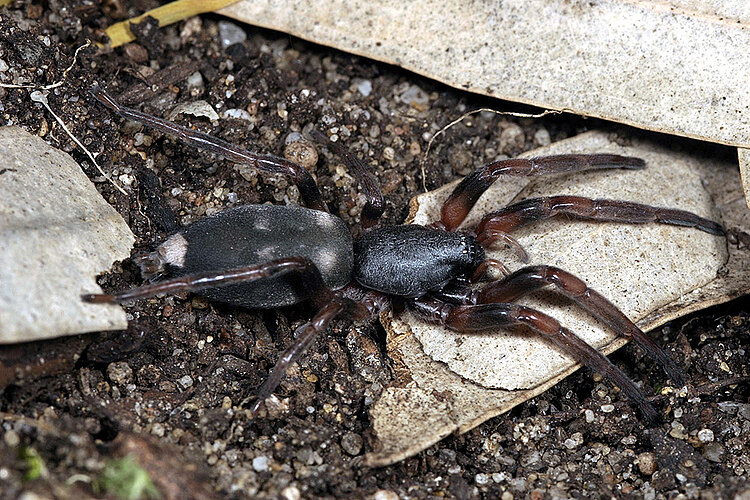White-tailed Spider Lampona cylindrata (L. Koch, 1866)
Fauna Portal species: 4311Diagnosis
(after Platnick 2000): Lampona cylindrata is very similar to L. murina and has often been confused with it in the past. Females are relatively easy to distinguish by spermathecal structure; the narrow, tubular, bulging spermathecae of L. cylindrata are quite different from the basally widened spermathecae with distinctly offset tips that are characteristic of L. murina. The epigynal fossa of L. cylindrata is also typically wider and more rounded than that of L. murina, with the outline of the spermathecae typically presenting a pair of circular spots just behind the posterior rim of the fossa. Differences in the male palpi are subtle; in L. cylindrata, the palpal femur is relatively long and narrow, and the retrolateral tibial apophysis is relatively long, relatively narrow at its base, and almost straight, whereas in L. murina the palpal femur is relatively short and thick, and the retrolateral tibial apophysis is relatively short, widened at its base, and distally curved. The medial portion of the membranous palpal conductor also differs between the two species, barely extending over the lateral portion of the conductor in L. cylindrata, but produced into a wide, rounded lobe covering the base of the lateral portion of the conductor in L. murina.
Linnean Type
(after Platnick 2000): Male lectotype, in effect designated by L. Koch, 1873: 373–375, who removed the female paralectotype from this species by using it as the holotype of L. ruida, from Australia [as ‘‘Neuholland’’], no specific locality, NHM).
Australia
- New South Wales
- Queensland
- South Australia
- Tasmania
- Victoria
- Western Australia
Fauna Portal Records
The map shows all records that have been verified as part of the Fauna Portal project and may not represent the true distribution of a species. Specifically, for described species, check the link to the Atlas of Living Australia on this page for potential wider distributions. Fauna Portal Reference specimens and Linnean types are shown in red. If you identified a specimen that exceeds the distribution of an undescribed species as illustrated here, please contact the Fauna Portal team who can assist with the lodgement of the specimen in a public institution and display on the map.
Publications
Platnick N.I. (2000): A relimitation and revision of the Australasian ground spider family Lamponidae (Araneae: Gnaphosoidea). Bulletin of the American Museum of Natural History. 245: 1 - 330
Araneae (Spiders)
- Actinopodidae
- Anamidae
- Araneae fam. indet.
- Araneidae
- Archaeidae
- Argyronetidae
- Arkyidae
- Barychelidae
- Cheiracanthiidae
- Clubionidae
- Corinnidae
- Cycloctenidae
- Deinopidae
- Desidae
- Dictynidae
- Filistatidae
- Gnaphosidae
- Halonoproctidae
- Hersiliidae
- Idiopidae
- Lamponidae
- Linyphiidae
- Lycosidae
- Mimetidae
- Miturgidae
- Mysmenidae
- Nicodamidae
- Oecobiidae
- Oonopidae
- Oxyopidae
- Philodromidae
- Pholcidae
- Pisauridae
- Prodidomidae
- Salticidae
- Scytodidae
- Segestriidae
- Selenopidae
- Sparassidae
- Symphytognathidae
- Tetrablemmidae
- Tetragnathidae
- Theridiidae
- Thomisidae
- Trachelidae
- Trachycosmidae
- Trochanteriidae
- Uloboridae
- Zodariidae
- Zoropsidae
All classes
- Arachnida
- Crustacea
- Entognatha
- Gastropoda
- Insecta
- Orthoptera - Caelifera (Grasshoppers)
- Hymenoptera excl. Formicidae (bees and wasps)
- Blattodea s. str. (Cockroaches)
- Coleoptera (Beetles)
- Dermaptera (earwigs)
- Diptera (flies, mosquitos)
- Entomobryomorpha (slender springtails)
- Hemiptera - Heteroptera (True Bugs)
- Hemiptera - Sternorrhyncha (aphids, scales etc.)
- Hemiptera - Auchenorrhyncha (cicadas, planthoppers)
- Hymenoptera - Formicidae (Ants)
- Trichoptera (Caddisflies)
- Zygentoma (silverfish)
- Myriapoda

